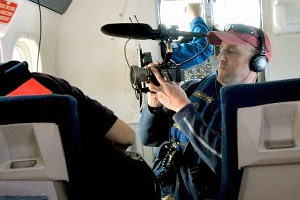 Producer Chris Bauer filming over the Gulf of the Farallones National Marine Sanctuary in NOAA’s Twin Sea Otter plane.
Producer Chris Bauer filming over the Gulf of the Farallones National Marine Sanctuary in NOAA’s Twin Sea Otter plane.
Much of the ocean waters off the coast of California, from Bodega Head to Cambria, have been set aside as national marine sanctuaries. The primary objective of the sanctuaries is to protect our delicate ocean resources while allowing people to use the areas in a sustainable way. While most recreation, commercial fishing, and shipping are still allowed within sanctuary waters, some activities are now strictly regulated or prohibited.
But how do you manage such an enormous area? And how do you keep tabs on what is going on out there? QUEST producers Lauren Sommer, Jenny Oh and I hitched a ride to find out.
On the windswept tarmac of the Sonoma County Airport, a team from the National Oceanic and Atmospheric Administration takes to the skies to patrol large portions of the Cordell Bank, Gulf of the Farallones and Monterey Bay National Marine Sanctuaries.
The mission of our Twin Otter flight crew, pilots Bradley Fritzler and Jason Mansour from NOAA Corps, along with sanctuary observers Sage Tezak and Michael Carver, is to conduct abundance surveys of users in the sanctuaries, counting boats and recording what they are doing and where.
